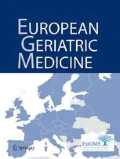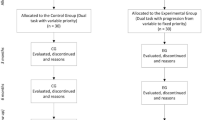Key summary points
With this study, we aimed to compare the effects of single- and dual-task training on gait and cognition among healthy older individuals, which can be adjusted weekly according to the individual’s functional performance.
AbstractSection FindingsAccording to the results of the study, the dual-task training group was better compared to the single-task training group in gait speed, cadence, and many cognitive variables.
AbstractSection RecommendationIndividual progressive dual-task training is an effective and useful method that improves gait performance and cognitive skills among older individuals. It is proposed to implement to maintain normal gait and cognitive function, and prevent possible gait and cognitive disabilities for healthy older individuals.
Abstract
Purpose
Dual-task training has beneficial effects on older individuals for gait and cognition. This study was aimed to make a comparison between the effects of individual progressive single- and dual-task training on gait and cognition among healthy older individuals.
Methods
A total of 32 participants were divided randomly into two groups as the single-task group (n = 16, 64.6 ± 3.3 years, 7 males and 9 females) and dual-task group (n = 16, 65.6 ± 2.6 years, 8 males and 8 females). The 10-m walk test with the LEGSys device was used to assess spatio-temporal gait parameters. The cognitive parameters were evaluated using the Standardized Mini-Mental State Exam and Stroop Test. An individual progressive 60 min single- and dual-task training programs were applied twice per week for a period of 6 weeks.
Results
There were significant differences for both gait and cognition variables in the dual-task training group (p < 0.05), according to the comparison of pre- and post-treatment results. In the single-task training group, there were significant differences only in gait parameters with single-task conditions (p < 0.05). The comparisons of the delta values between the groups indicated that the dual-task training group was better compared to the single-task training group in gait speed, cadence, and many cognitive variables (p < 0.05).
Conclusion
Individual progressive dual-task training is an effective and useful method that improves gait performance and cognitive skills among older individuals.
Trial registration number and date
NCT03777111, 12/13/2018.

Similar content being viewed by others
Data availability
The authors confirm that the data supporting the findings of this study are available within the article [and/or] its supplementary materials.
References
Abe T, Kitamura A, Taniguchi Y, Amano H, Seino S, Yokoyama Y et al (2019) Pathway from gait speed to incidence of disability and mortality in older adults: a mediating role of physical activity. Maturitas 123:32–36. https://doi.org/10.1016/j.maturitas.2019.02.002
Freire Junior RC, Porto JM, Rodrigues NC, Brunelli RM, Braga LF, de Abreu DC (2016) Spatial and temporal gait characteristics in pre-frail community-dwelling older adults. Geriatr Gerontol Int 16(10):1102–1108. https://doi.org/10.1111/ggi.12594
Marques NR, Spinoso DH, Cardoso BC, Moreno VC, Kuroda MH, Navega MT (2018) Is it possible to predict falls in older adults using gait kinematics? Clin Biomech (Bristol, Avon) 59:15–18. https://doi.org/10.1016/j.clinbiomech.2018.08.006
Cruz-Jimenez M (2017) Normal changes in gait and mobility problems in the elderly. Phys Med Rehabil Clin N Am 28(4):713–725. https://doi.org/10.1016/j.pmr.2017.06.005
Prince F, Corriveau H, Hébert R, Winter DA (1997) Gait in the elderly. Gait Posture 5(2):128–135. https://doi.org/10.1016/S0966-6362(97)01118-1
Smith E, Cusack T, Cunningham C, Blake C (2017) The influence of a cognitive dual task on the gait parameters of healthy older adults: a systematic review and meta-analysis. J Aging Phys Act 25(4):671–686. https://doi.org/10.1123/japa.2016-0265
Montero-Odasso M, Verghese J, Beauchet O, Hausdorff JM (2012) Gait and cognition: a complementary approach to understanding brain function and the risk of falling. J Am Geriatr Soc 60(11):2127–2136. https://doi.org/10.1111/j.1532-5415.2012.04209.x
Falbo S, Condello G, Capranica L, Forte R, Pesce C (2016) Effects of physical-cognitive dual task training on executive function and gait performance in older adults: a randomized controlled trial. Biomed Res Int 2016:5812092. https://doi.org/10.1155/2016/5812092
Wollesen B, Mattes K, Schulz S, Bischoff LL, Seydell L, Bell JW et al (2017) Effects of dual-task management and resistance training on gait performance in older individuals: a randomized controlled trial. Front Aging Neurosci 9:415. https://doi.org/10.3389/fnagi.2017.00415
Wollesen B, Schulz S, Seydell L, Delbaere K (2017) Does dual task training improve walking performance of older adults with concern of falling? BMC Geriatr 17(1):213. https://doi.org/10.1186/s12877-017-0610-5
Wollesen B, Voelcker-Rehage C (2013) Training effects on motor–cognitive dual-task performance in older adults. Eur Rev Aging Phys Act 11(1):5–24. https://doi.org/10.1007/s11556-013-0122-z
Sherrington C, Fairhall NJ, Wallbank GK, Tiedemann A, Michaleff ZA, Howard K et al (2019) Exercise for preventing falls in older people living in the community. Cochrane Database Syst Rev. 1:CD012424. https://doi.org/10.1002/14651858.CD012424.pub2
Peters DM, Fritz SL, Krotish DE (2013) Assessing the reliability and validity of a shorter walk test compared with the 10-meter walk test for measurements of gait speed in healthy, older adults. J Geriatr Phys Ther 36(1):24–30. https://doi.org/10.1519/JPT.0b013e318248e20d
Podsiadlo D, Richardson S (1991) The timed “Up & Go”: a test of basic functional mobility for frail elderly persons. J Am Geriatr Soc 39(2):142–148. https://doi.org/10.1111/j.1532-5415.1991.tb01616.x
Beauchet O, Fantino B, Allali G, Muir SW, Montero-Odasso M, Annweiler C (2011) Timed Up and Go test and risk of falls in older adults: a systematic review. J Nutr Health Aging 15(10):933–938. https://doi.org/10.1007/s12603-011-0062-0
Kalem ŞA, Öktem Ö, Emre M (2002) Kısa Blessed Oryantasyon-Bellek-Konsantrasyon Testi (BOMC) ve Standardize Mini Mental Test (SMMT) betimsel istatistik değerlerinin bir normal erişkin Türk örnekleminde saptanması. Nöropsikiyatr Arş 39(2–3–4):95–102
Karakaş S, Erdoğan E, Sak L, Alkan S (1999) Stroop Testi TBAG Formu: Türk kültürüne standardizasyon çalışmaları, güvenirlik ve geçerlik. Klin Psikiyatr Derg 2:75–88
Brustio PR, Rabaglietti E, Formica S, Liubicich ME (2018) Dual-task training in older adults: The effect of additional motor tasks on mobility performance. Arch Gerontol Geriatr 75:119–124. https://doi.org/10.1016/j.archger.2017.12.003
van het Reve E, de Bruin ED (2014) Strength-balance supplemented with computerized cognitive training to improve dual task gait and divided attention in older adults: a multicenter randomized-controlled trial. BMC Geriatr 14:134. https://doi.org/10.1186/1471-2318-14-134
Shin SS, An DH (2014) The effect of motor dual-task balance training on balance and gait of elderly women. J Phys Ther Sci 26(3):359–361. https://doi.org/10.1589/jpts.26.359
Kikkert LHJ, Vuillerme N, van Campen JP, Appels BA, Hortobágyi T, Lamoth CJC (2018) The relationship between gait dynamics and future cognitive decline: a prospective pilot study in geriatric patients. Int Psychogeriatr 30(9):1301–1309. https://doi.org/10.1017/s1041610217002770
Toots ATM, Taylor ME, Lord SR, Close JCT (2019) Associations between gait speed and cognitive domains in older people with cognitive impairment. J Alzheimers Dis 71(s1):S15-s21. https://doi.org/10.3233/jad-181173
Cohen JA, Verghese J, Zwerling JL (2016) Cognition and gait in older people. Maturitas 93:73–77. https://doi.org/10.1016/j.maturitas.2016.05.005
Rigoli D, Piek JP, Kane R, Oosterlaan J (2012) An examination of the relationship between motor coordination and executive functions in adolescents. Dev Med Child Neurol 54(11):1025–1031. https://doi.org/10.1111/j.1469-8749.2012.04403.x
Kramer AF, Larish JL (1996) Aging and dual-task performance. In: Rogers WA, Fisk AD, Walker N (eds) Aging and skilled performance: advances in theory and applications. Lawrence Erlbaum Associates, Inc, Hillsdale, pp 83–112
McDowd JM, Shaw RJ (2000) Attention and aging: A functional perspective. In: Craik FIM, Salthouse TA (eds) The handbook of aging and cognition, 2nd edn. Lawrence Erlbaum Associates Publishers, Mahwah, pp 221–292
Kramer AF, Larish JL, Weber TA, Bardell L (1999) Training for executive control: Task coordination strategies and aging. In: Gopher D, Koriat A (eds) Attention and performance. Attention and performance XVII: cognitive regulation of performance: interaction of theory and application. MIT, Cambridge, pp 617–652
Fraser SA, Li KZ, Berryman N, Desjardins-Crepeau L, Lussier M, Vadaga K et al (2016) Does combined physical and cognitive training improve dual-task balance and gait outcomes in sedentary older adults? Front Hum Neurosci 10:688. https://doi.org/10.3389/fnhum.2016.00688
Dorfman M, Herman T, Brozgol M, Shema S, Weiss A, Hausdorff JM et al (2014) Dual-task training on a treadmill to improve gait and cognitive function in elderly idiopathic fallers. J Neurol Phys Ther 38(4):246–253. https://doi.org/10.1097/NPT.0000000000000057
Brum PS, Borella E, Carretti B, Yassuda MS (2020) Working memory training format in older adults: individual versus group sessions. Aging Clin Exp Res. https://doi.org/10.1007/s40520-019-01468-0
Funding
Not applicable. The authors received no specific funding for this work.
Author information
Authors and Affiliations
Contributions
All authors contributed to the study conception and design. Material preparation, data collection, and analysis were performed by ETH and SYC. The first draft of the manuscript was written by ETH and all authors commented on previous versions of the manuscript. All authors read and approved the final manuscript.
Corresponding author
Ethics declarations
Conflict of interest/Competing Interests
The authors declare that they have no conflict of interest/competing interest to declare that are relevant to the content of this article. The authors did not receive support from any organization for the submitted work.
Ethical approval
This study was performed in line with the principles of the Declaration of Helsinki. Approval was granted by the Ethics Committee of University B (Date: 08/08/2018 No. 60116787-020/53283).
Informed consent
Written informed consent was obtained from all participants after they were verbally briefed about the aims of the study.
Additional information
Publisher's Note
Springer Nature remains neutral with regard to jurisdictional claims in published maps and institutional affiliations.
Rights and permissions
About this article
Cite this article
Tasvuran Horata, E., Cetin, S.Y. & Erel, S. Effects of individual progressive single- and dual-task training on gait and cognition among older healthy adults: a randomized-controlled comparison study. Eur Geriatr Med 12, 363–370 (2021). https://doi.org/10.1007/s41999-020-00429-5
Received:
Accepted:
Published:
Issue Date:
DOI: https://doi.org/10.1007/s41999-020-00429-5




